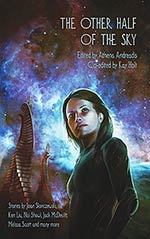
![]() FeminineFantastique
FeminineFantastique
5/18/2014
![]()
The Other Half of the Sky is a 2013 science fiction anthology edited by Athena Andreadis and Kay T. Holt; its sixteen stories all feature female protagonists. Within it you'll find familiar names such as Joan Slonczewski, Melissa Scott, and Ken Liu, in addition to in all likelihood some new-to-you authors whose writing it is an immense pleasure to become acquainted with.
It includes Aliette de Bodard's "The Waiting Stars," which won this year's Nebula Award for best novelette and was also nominated for the Hugo and Locus Awards. Upon reading De Bodard's story — in which the two protagonists are in positions that couldn't be more different, as one is unhappily but comfortably institutionalized and the other is evading government operatives — it is my opinion that it certainly deserves winning all three of those awards.
In my experience, good science fiction either makes you think or makes you feel, and uncommonly it does both. Short fiction has substantially less room to accomplish these objectives, and "The Waiting Stars" manages it. I found myself becoming a little weepy at the end, both for the sadness of the protagonists' lives irrevocably changing and for the yearning hope for their futures. This is a postcolonial story, the one I found most deeply emotionally resonant, and one not just about the allure of the stars but of sacrifice and love and what it means to be family.
"Sailing the Antarsa," by Vandana Singh, was another favorite. As the story opens the protagonist is alone on a tiny ship in interstellar space searching for any remnants of Earth's descendents that may have found other worlds. As we read of her lonely voyage, we have only her memories to tell us of the world she came from, in which humans genetically modified themselves to inflict as little harm as possible on their new environment, and in which they discover new kinds of matter, methods of bio-engineering, and methods of space exploration, all by studying their local ecology. Of the stories in the anthology, this is the one I found most intriguing on a scientific level.
Nisi Shawl's "Colours Everywhere" takes place in a far-future planetary penal colony with a female-dominated internal system of governance. We are left to wonder if the "crimes" that result in being placed in this gentle prison — for while the power of their guards is a looming threat and its residents are not allowed much technology, the planet seems pretty idyllic — are simply those of "otherness." While self-contained, the story set up a mystery about the faunae on this planet that I am quite invested in, and overall this was the story within the anthology that most made me wish I could read more about the world. So I was pleased to discover that it's an ongoing series.
(Actually, this is true of several of the stories, including De Bodard's novelette and Martha Wells' "Mimesis," another favorite of mine: that they are either part of a series or have companion works elsewhere. So in addition to being an unusual and well-rounded anthology, The Other Half of the Sky will introduce you to some previously unknown science fiction universes that also exist elsebook.)
When editors Kay T. Holt and Athena Andreadis first brainstormed this anthology, the idea was to have space-oriented science fiction stories with exclusively female protagonists, ones that were not defined by their roles in the lives of men but that were characters with agency. Then they moved beyond this idea to facilitate the creation of new realities by removing assumptions about culture: Manifest Destiny-type conquest. Ecological destruction. Patriarchy. Heteronormativity.
A start from scratch.
As a result we have a batch of stories here that don't just feature women as protagonists, often characters of color and those with LGBT identities, but in which the societies within create wholly new ways of living: sociologically, technologically, ecologically. The social structures and worlds that these authors wrote are so unique and inventive that I kept forgetting that I was reading a book with a mission, that I was promised female protagonists, and thinking: Ah, yes. This is what science fiction should be.
Welcome to the future.
http://manicpixiedreamworlds.wordpress.com/